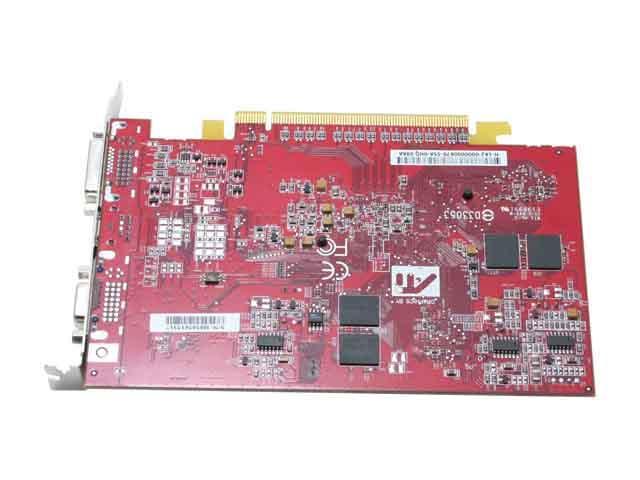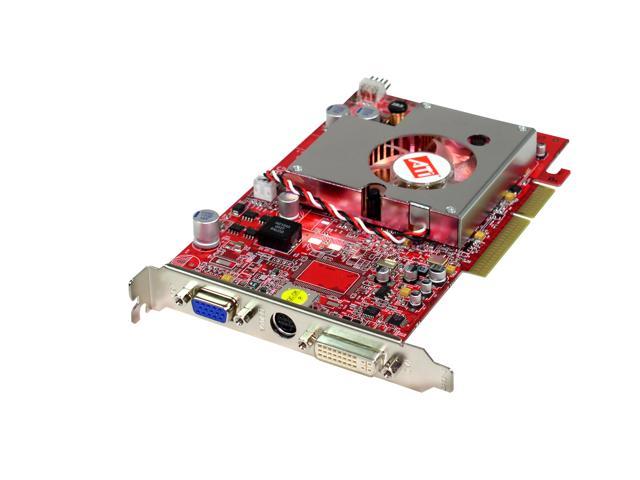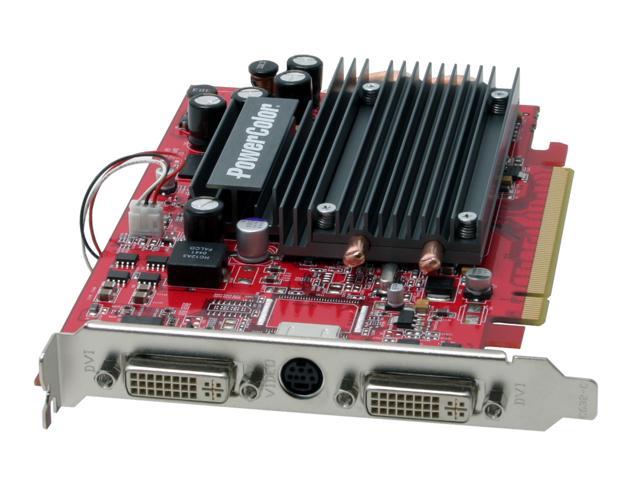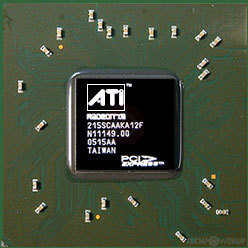Overclocking
Download latest graphics drivers for AMD/ATI Radeon X700 and Microsoft Windows XP 32bit. PowerColor RADEON X700 256MB AGP is a good product, if its price is below $130 (this card is already available at 110-120 USD, which is good news). If you already have the RADEON 9800 or the RADEON 9700 PRO, there is no point in buying the X700. This upgrade is justified only from older or weaker models. 2D quality at 1600x1200@85Hz is good.
With manual overclocking, maximum overclock of our sample is 1900 MHz on the memory (9% overclock) and 2086 MHz on the GPU, which increases average GPU clock from 1910 MHz to 2000 MHz (5% overclock). Memory overclocking is now limited by the length of the slider in Wattman, which stops at 950 MHz.
| Maximum Overclock Comparison | |||
|---|---|---|---|
| Avg. GPU Clock | Max. Memory Clock | Performance | |
| AMD RX 5700 | 1726 MHz | 1860 MHz | 101.5 FPS |
| AMD RX 5700 XT | 2015 MHz | 1840 MHz | 118.1 FPS |
| ASUS RX 5700 XT STRIX | 2031 MHz | 1900 MHz | 118.3 FPS |
| MSI RX 5700 XT Evoke | 2050 MHz | 1900 MHz | 119.6 FPS |
| PowerColor RX 5700 XT Red Devil | 2000 MHz | 1900 MHz | 117.0 FPS |
| Sapphire RX 5700 XT Pulse | 2001 MHz | 1900 MHz | 117.8 FPS |
Overclocked Performance
Using these clock frequencies, we ran a quick test of Unigine Heaven to evaluate the gains from overclocking.

Powercolor Radeon Drivers
Actual 3D performance gained from overclocking is 1.5%.
Introduction
 PowerColor today launched the Radeon RX 5700 XT Red Devil, its flagship custom-design graphics card based on the new 7 nm AMD RX 5700 XT Navi graphics processor. This card arrives hot on the heels of AMD's add-in board partners launching custom-design Radeon RX 5700-series graphics cards a little over a month following the July 7th launch of Navi. The Red Devil is positioned as an extremely premium offering, right in the middle of NVIDIA's RTX 2060 Super and RX 2070 Super and priced at $440 ($450 for a premium package with more accessories, which we cover in this review). The PowerColor RX 5700 XT Red Devil tops Navi with a factory overclock, a gargantuan cooling solution that looks a class above, and has many enthusiast features you'd expect from much pricier cards.
PowerColor today launched the Radeon RX 5700 XT Red Devil, its flagship custom-design graphics card based on the new 7 nm AMD RX 5700 XT Navi graphics processor. This card arrives hot on the heels of AMD's add-in board partners launching custom-design Radeon RX 5700-series graphics cards a little over a month following the July 7th launch of Navi. The Red Devil is positioned as an extremely premium offering, right in the middle of NVIDIA's RTX 2060 Super and RX 2070 Super and priced at $440 ($450 for a premium package with more accessories, which we cover in this review). The PowerColor RX 5700 XT Red Devil tops Navi with a factory overclock, a gargantuan cooling solution that looks a class above, and has many enthusiast features you'd expect from much pricier cards. 
Powercolor Radeon Rx 550
The Radeon RX 5700 XT is AMD's first true performance-segment graphics card in over two years since the RX Vega series. It's based on the brand new 'Navi' architecture that leverages the 7 nm silicon fabrication proces and brand new number-crunching machinery AMD calls RDNA compute units. These constitute the biggest update to AMD's GPU design since the very first Graphics CoreNext (GCN) architecture circa 2013. Together with clock speeds, RDNA is designed to bring about massive IPC improvements over GCN. The silicon also has a number of architectural changes. An interesting series of price adjustments and product launches ensures that even at its starting price of $399, it offers a bit more price-performance than NVIDIA.AMD had originally planned to launch the Radeon RX 5700 XT at $449 and the RX 5700 at $399, with the two cards beating the $499 NVIDIA RTX 2070 and $349 RTX 2060, respectively. This forced NVIDIA to refresh its lineup with the new RTX 2070 Super at $499 and the RTX 2060 Super at $399. The RTX 2060 Super in particular was carefully crafted not to cannibalize the RTX 2070. AMD seeped into this imbroglio of NVIDIA and slotted the RX 5700 XT at $399 and the RX 5700 at $349, at which prices they outclass the RTX 2060 Super and original RTX 2060, respectively. NVIDIA didn't adjust prices of its RTX 2060 Super or RTX 2070 Super any further, and we hence have a fair bit of headroom between the RTX 2060 Super and the RTX 2070 Super in which AMD's board partners can launch custom-design RX 5700 XT cards with factory-overclocked speeds and other goodies, such as quieter coolers.
At the heart of the Radeon RX 5700 XT is the 7 nm 'Navi 10' silicon with an impressive 10.3 billion transistors crammed into a 251 mm² die. Unlike the 'Vega 20', Navi is a more traditional GPU in that the package only has the GPU die and is surrounded by memory chips. AMD opted for cost-effective 256-bit GDDR6 memory over exotic design choices such as HBM2. At a memory frequency of 14 Gbps, Navi enjoys a healthy memory bandwidth of 448 GB/s. It also features the latest-generation PCI-Express gen 4.0 x16 host interface with full backwards compatibility for older generations of PCIe, so you can pair it with AMD's new Ryzen 3000 processors on an X570 chipset motherboard. The buzz-words '7 nm' and 'PCIe gen 4.0' are extensively used in AMD's marketing, as if to suggest that Navi is a generation ahead of NVIDIA's Turing, which is built on 12 nm and has PCIe gen 3.0.
The PowerColor Radeon RX 5700 XT Red Devil features a custom-design, triple-slot cooling solution that features a massive compound aluminium fin-stack heatsink that uses several copper heat pipes which pass through multiple fin stacks ventilated by a trio of fans. This overkill cooling solution not only gives you idle fan stop, but also supports the card's increased power limits and factory-overclocked speeds of up to 1905 MHz boost. You also get several features, such as Dual BIOS, with one of two BIOSes activating a 'Quiet Mode' that significantly reduces fan noise when gaming, and an accessory package that includes an RGB mousepad. All this for a $50 premium over the $400 baseline.
Powercolor Radeon Rx 570 4gb
Powercolor Radeon Rx 570 Driver
| Price | Shader Units | ROPs | Core Clock | Boost Clock | Memory Clock | GPU | Transistors | Memory | |
|---|---|---|---|---|---|---|---|---|---|
| GTX 1070 Ti | $450 | 2432 | 64 | 1607 MHz | 1683 MHz | 2000 MHz | GP104 | 7200M | 8 GB, GDDR5, 256-bit |
| RTX 2060 | $290 | 1920 | 48 | 1365 MHz | 1680 MHz | 1750 MHz | TU106 | 10800M | 6 GB, GDDR6, 192-bit |
| RX 5700 | $350 | 2304 | 64 | 1465 MHz | 1625 MHz | 1750 MHz | Navi 10 | 10300M | 8 GB, GDDR6, 256-bit |
| GTX 1080 | $500 | 2560 | 64 | 1607 MHz | 1733 MHz | 1251 MHz | GP104 | 7200M | 8 GB, GDDR5X, 256-bit |
| RTX 2060 Super | $400 | 2176 | 64 | 1470 MHz | 1650 MHz | 1750 MHz | TU106 | 10800M | 8 GB, GDDR6, 256-bit |
| RX Vega 64 | $400 | 4096 | 64 | 1247 MHz | 1546 MHz | 953 MHz | Vega 10 | 12500M | 8 GB, HBM2, 2048-bit |
| GTX 1080 Ti | $700 | 3584 | 88 | 1481 MHz | 1582 MHz | 1376 MHz | GP102 | 12000M | 11 GB, GDDR5X, 352-bit |
| RX 5700 XT | $400 | 2560 | 64 | 1605 MHz | 1755 MHz | 1750 MHz | Navi 10 | 10300M | 8 GB, GDDR6, 256-bit |
| PowerColor RX 5700 XT Red Devil | $450 | 2560 | 64 | 1770 MHz | 1905 MHz | 1750 MHz | Navi 10 | 10300M | 8 GB, GDDR6, 256-bit |
| RTX 2070 | $440 | 2304 | 64 | 1410 MHz | 1620 MHz | 1750 MHz | TU106 | 10800M | 8 GB, GDDR6, 256-bit |
| RTX 2070 Super | $500 | 2560 | 64 | 1605 MHz | 1770 MHz | 1750 MHz | TU104 | 13600M | 8 GB, GDDR6, 256-bit |
| Radeon VII | $680 | 3840 | 64 | 1802 MHz | N/A | 1000 MHz | Vega 20 | 13230M | 16 GB, HBM2, 4096-bit |
| RTX 2080 | $630 | 2944 | 64 | 1515 MHz | 1710 MHz | 1750 MHz | TU104 | 13600M | 8 GB, GDDR6, 256-bit |
